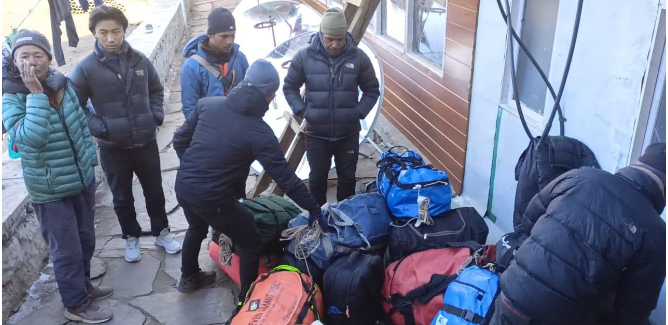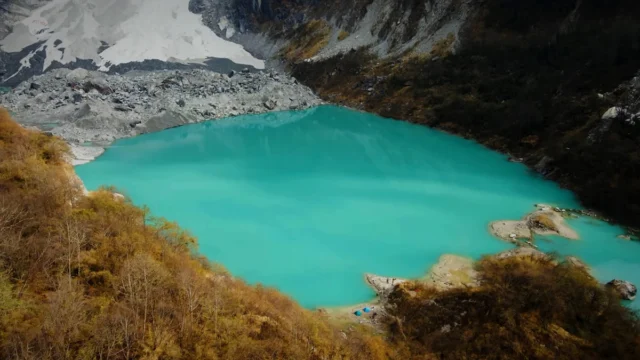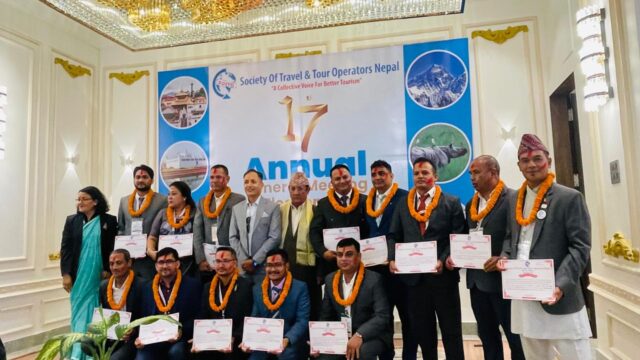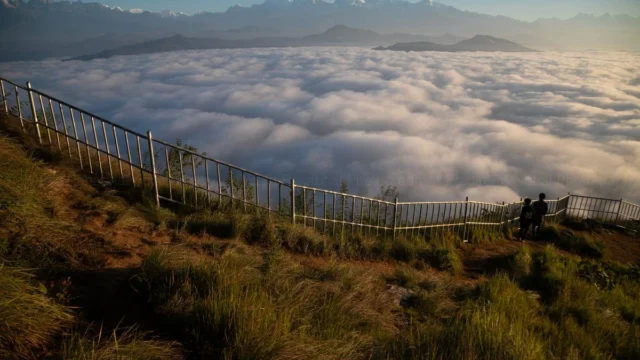While the rest of Nepal enjoys the warmth and festivity of Dashain, in Khumbu, the high Himalayan region of Solukhumbu, the scene is quite different. For locals like 24-year-old Navin Rai from Sotang, Dashain takes a back seat as the peak tourist season demands their full attention. On the day of Phulpati, while others return home to celebrate, Rai embarked on a journey to Khumbu, seeking work as a porter for foreign tourists.
“For us, there’s no difference between Dashain or any other time of the year. It’s tourist season in Khumbu, and friends have already brought foreigners. I need to go carry their loads,” Rai shared with a sigh. “I have a family to support—my parents, younger siblings. If I stayed home for Dashain, who would take care of the household? I’ll be celebrating Dashain carrying loads in Khumbu,” he added.
Rai is not alone. Many youths from the lower regions of Solukhumbu have migrated to Khumbu during this time, seeking work. Even students, like Ramesh Bik, who are usually busy with their studies, take advantage of the Dashain holidays to earn money by carrying loads for tourists in Lukla and Namche. “This is the season when I can cover my tuition fees. Carrying loads for foreign tourists helps me pay for my studies,” Bik, a student at a local campus in Salleri, explained.
With thousands of Nepalis heading home for the Dashain festival, Khumbu becomes a hub of activity, not for celebration, but for work. Young men like Pradip Magar from Gorakhani climb steep hills with heavy loads on their backs, earning their daily wages during the tourist rush. “I don’t care about Dashain. If we don’t work now, it’s hard to make ends meet later,” Magar shared, adding that he hasn’t celebrated Dashain in five years due to work commitments.
Khumbu, home to the world’s tallest mountain, Mount Everest, is a major tourist destination, especially during the trekking season, which starts in late August and runs through the autumn months. According to statistics from Khumbu Pasang Lhamu Rural Municipality, around 300 foreign tourists arrive daily in the region during peak season, creating a surge in demand for porters, guides, and other tourism-related services. Amrit Magar, a tourism entrepreneur from Lukla, noted that while festivals like Dashain are important, they must prioritize their livelihoods. “We come here to make the tourists happy. We sacrifice our happiness to ensure their satisfaction,” he said.
For many involved in the tourism sector, like Diku Bahadur Darnal from Serkasing, the tourist season is their primary focus. “There are only about six months of tourism each year, so we must work hard during this time. I haven’t been able to stay home for Dashain for years,” Darnal, a seasoned tourist guide, shared. Trekking companies send workers home during the off-season, but during this time, it’s all hands on deck. Darnal has spent the last 20 years working in Khumbu, foregoing festivals to meet the demands of tourists.
With over 200 daily flights and more than 1,000 tourists arriving in Khumbu by air each day, according to Umesh Panthi, head of the Civil Aviation Authority in Lukla, the region’s hotels and lodges are operating at full capacity. Lama Kaji Sherpa, a hotel owner in Namche, mentioned that “hotels that are usually empty during other times are now fully booked. It’s hard to find accommodation for everyone.”
Even government employees are caught in the hustle. Staff at checkpoints in Sagarmatha National Park and local offices in Khumbu are working tirelessly to manage the influx of tourists. Manoj Kumar Mandal, an information officer at the park, said that staff members take turns celebrating Dashain due to the workload. “With so many tourists, we can’t all go home for the festival. But we enjoy our work and make the best of it,” he shared.
For many in Khumbu, the tourist season is a time of opportunity, even if it means putting family traditions and festive celebrations on hold. The economic benefits of serving tourists are too significant to pass up, making Dashain in Khumbu a quieter, yet busy affair.
Source: RSS






